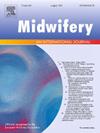Cross-cultural adaptation of the women's experience of vaginal examination in labour scale in the Brazilian cultural context
IF 2.5
3区 医学
Q1 NURSING
引用次数: 0
Abstract
Objective
To carry out the cross-cultural adaptation of the Women's Experience of Vaginal Examination in Labour scale in the Brazilian cultural context and to evaluate the psychometric properties of the proposed version.
Methods
The stages of cross-cultural adaptation were carried out. The pre-test version was applied to 10 primiparous women in the immediate postpartum period who gave birth to full-term newborns via vaginal delivery with cephalic presentation. To assess reliability and validity, the final proposed version was administered to 200 women with the same characteristics in a cross-sectional study. Data were analyzed using exploratory factor analysis with principal component extraction and Item Response Theory.
Results
The Brazilian version of the scale was obtained following rigorous adherence to all stages. In the reliability analysis, the Brazilian version scale presented a Cronbach's α of 0.909. Factor analysis with principal component extraction showed closely distributed factors, explaining 66.5 % of the variance. The Item Response Theory analysis indicated that the probability of selecting a particular response varies depending on the intensity of the latent trait.
Conclusion
A valid and reliable Brazilian version of the Women's Experience of Vaginal Examination in Labour scale was obtained.
巴西文化背景下劳动规模下女性阴道检查经验的跨文化适应
目的对《分娩女性阴道检查经历》量表在巴西文化背景下进行跨文化改编,并评价拟编量表的心理测量学特征。方法进行跨文化适应阶段研究。预测试版本应用于10名产后刚分娩的孕妇,她们通过阴道分娩生下足月新生儿,头位呈现。为了评估信度和效度,在横断面研究中对200名具有相同特征的女性进行了最终的建议版本。采用探索性因子分析、主成分提取和项目反应理论对数据进行分析。结果在严格遵守所有阶段后获得了巴西版量表。在信度分析中,巴西版量表的Cronbach’s α为0.909。主成分提取的因子分析表明,各因子分布紧密,解释了66.5%的方差。项目反应理论分析表明,选择特定反应的概率取决于潜在特质的强度。结论获得了一份有效、可靠的巴西版《分娩时妇女阴道检查经验》。
本文章由计算机程序翻译,如有差异,请以英文原文为准。
求助全文
约1分钟内获得全文
求助全文
来源期刊

Midwifery
医学-护理
CiteScore
4.50
自引率
7.40%
发文量
221
审稿时长
13.4 weeks
期刊介绍:
Midwifery publishes the latest peer reviewed international research to inform the safety, quality, outcomes and experiences of pregnancy, birth and maternity care for childbearing women, their babies and families. The journal’s publications support midwives and maternity care providers to explore and develop their knowledge, skills and attitudes informed by best available evidence.
Midwifery provides an international, interdisciplinary forum for the publication, dissemination and discussion of advances in evidence, controversies and current research, and promotes continuing education through publication of systematic and other scholarly reviews and updates. Midwifery articles cover the cultural, clinical, psycho-social, sociological, epidemiological, education, managerial, workforce, organizational and technological areas of practice in preconception, maternal and infant care.
The journal welcomes the highest quality scholarly research that employs rigorous methodology. Midwifery is a leading international journal in midwifery and maternal health with a current impact factor of 1.861 (© Thomson Reuters Journal Citation Reports 2016) and employs a double-blind peer review process.
 求助内容:
求助内容: 应助结果提醒方式:
应助结果提醒方式:


